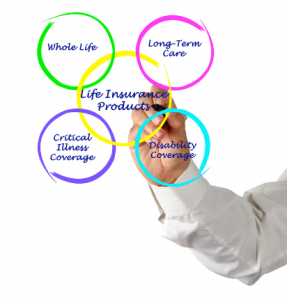
Types of Life Insurance
Life insurance typically comes in two forms, depending on the desired length of coverage: term life insurance or whole life insurance. Other forms include:
- Yearly renewable term life insurance that covers a single year, but can be renewed without evidence of insurability; and
- Universal life insurance, a type of whole life policy that is much more flexible and more of an investment tool.
There are a few other major differences between them.
| Term Life Insurance | Yearly Renewable Term Life Insurance | Whole Life Insurance | Universal Life Insurance |
|---|---|---|---|
| Term life insurance is designed to cover you for a pre-designated age range, but can be renewed or converted | Yearly Renewable Term Life Insurance is designed to cover you for one year and needs to be renewed | Whole life insurance is designed to cover you for life | Universal life insurance is designed to cover you for life |
| Lowest overall premium – can stay the same or start low and increase with age | Lower initial premium than term life insurance; increases with age | Highest premium – stays the same throughout the policy | Lower premium – can vary over time, depending on your needs and contributions to cash value |
| Accrues no cash value | Accrues no cash value | Cash value increases at a predetermined rate Interest on cash value accrues at a fixed rate | Cash value increases by the amount you elect to contribute Interest on cash value fluctuates with the market |
| Many insurers offer riders that protect your death benefit if you become disabled, critically ill, or terminally ill. You may be limited on when you can add these riders, so check with your insurance agent. | |||
Term Life Insurance
 Term insurance policies typically cover the stages of life where your income is most important for your family, such as having minor children or a mortgage. It is designed to cover you for a pre-designated age range or term that you determine when you start the policy. The typical term is 10, 20, or 30 years. Most companies will have an age limit above which a policy will stop, usually 80-90 years old.
Term insurance policies typically cover the stages of life where your income is most important for your family, such as having minor children or a mortgage. It is designed to cover you for a pre-designated age range or term that you determine when you start the policy. The typical term is 10, 20, or 30 years. Most companies will have an age limit above which a policy will stop, usually 80-90 years old.
Term life insurance’s only function is to provide money for your family if you die. It accrues no cash value and if you are alive when the policy expires, no benefits are paid out.
- Your premiums are based on the duration of the policy, the policy’s value (settlement/payout amount or death benefit), your gender, age, health when the policy goes into effect, life expectancy, and your insurer’s costs and profits.
- Without a cash value, there is no way to prevent forfeiting your insurance if you can’t pay your premium.
- Some companies will sell you a policy or let you to add riders to:
- Allow the conversion the policy to whole life insurance; and/or
- Return your premiums if you outlive your policy, although you will pay much higher premiums for that option.
- Since financial needs may differ depending on your stage in life, the duration of the policy can reflect this.
There may be reasons you would want temporary coverage during a specific time interval.
Term life insurance premiums are the cheapest — less than 10% of the cost of whole life for the same coverage — and it could be the only thing you can afford for now.
The goal is to prevent financial difficulties for your surviving loved ones, so the policy may only be necessary for the times that will be true.
- A mortgage could be a significant burden on a surviving spouse, so you may only need a policy until you pay off the mortgage.
- In this case you can opt for a decreasing term life policy where the death benefit decreases with the amount of mortgage owed.
- The same applies to any debt your spouse or other family member has cosigned.
- If you are planning to pay for some or all of the cost of your children’s college, you may only need the policy until such time you can afford it with savings or they are in their last semester.
- You may only need a policy until your children are self-sufficient.
- You may no longer have a salary when you retire that needs to be replaced by a life insurance settlement or a business to keep running.
It may be possible to adjust the amount of the death benefit to adapt to your needs.
 The higher the death benefit, the higher the premium.
The higher the death benefit, the higher the premium.
If you are healthy, you can choose a premium that stays the same until the policy expires or one that is lower when you are younger and less financially secure that increases as you get older.
Level term or level-premium life policies provide coverage for a pre-specified period.
- Both the death benefit and premium are fixed.
- The premium is typically higher than the initial premiums of yearly renewable term life insurance.
Yearly renewable term life policies have to be renewed every year.
- The premiums are initially less than a standard term life insurance policy, but increase with age.
- They can become prohibitively expensive for longer terms, making it a poor choice if you want to keep the policy indefinitely.
Decreasing term policies have a death benefit that declines each year, according to a predetermined schedule.
- You pay a fixed, level premium for the duration of the policy.
- It is the most affordable type since this premium is lower than other types of term insurance.
- Decreasing term policies are often used in concert with a mortgage to match the coverage with the declining principal of the home loan.
If you have health problems or risk factors such as smoking, your premiums may automatically increase as you age.
They may be renewed, but premiums continue to increase as you may develop other risk factors.
You can usually extend your policy or convert it to whole life if/when you can afford to.
Your premiums will be based on your age, health, and other risk factors at the time you renew or convert.
Your medical condition may prevent you from renewing.
- To avoid this, a yearly renewable term life policy can be renewed each year without providing evidence of insurability.
- A convertible term life insurance policy can include a clause or an added rider guaranteeing you the right to convert to a permanent plan without going through underwriting or proving insurability.
- This allows you to convert to any whole life policy the insurance company offers with no restrictions.
- You will be able to maintain the original health rating of the term policy, even if you have developed health issues or become uninsurable.
- You can decide when and how much of the coverage to convert.
- The basis for the premium of the new whole life policy is your age at conversion, not your current health status. The premium will increase significantly since whole life insurance is more expensive than term life insurance.
You may be able to cancel your policy at any time.
You will need to check with your insurance company for the details of your policy, but there are some general considerations.
- If you change your mind and/or want life insurance after canceling, the premium can be higher depending on the time you were uninsured.
- You have a “Free look” period (usually 10-30 days) when you can cancel without consequence.
- While stopping payments will cancel your policy, it may not be the best way. This can have effects on your credit score.
- It’s best to contact your insurance company and make it official with a written notice.
Whole Life Insurance
 While term life insurance is adequate for most situations, you may want to consider whole life insurance as a way to leave money to your family or as an investment.
While term life insurance is adequate for most situations, you may want to consider whole life insurance as a way to leave money to your family or as an investment.
A whole life insurance settlement can be a way to provide tax-free inheritance for your heirs.
- In 2023, estates worth more than $12.92 million are subject to federal estate taxes. A death benefit may be a way to provide additional tax-free money.
- Whole life can be considered a poor investment. It may be best to only use it as such when you have exceeded other tax-free limits and/or to leave enough to pay expected inheritance or estate taxes.
A whole life insurance is appropriate if your family will always need financial support, such as having a lifelong dependent with special needs.
You may want to assure your family has money for final expenses no matter when you die, rather than if you die during a certain interval or term.
The savings portion of these whole life policies is referred to as the cash value.
Cash value generally increases at a predetermined rate which is based on the percent of the premium being put into savings and investment of cash value accruing interest at a fixed rate.
Cash value is not typically intended to go to your beneficiaries after your death.
You can buy an increasing death benefit policy or add a rider — at additional cost — to the policy that allows this, therefore increasing the death benefit.
There is a type of whole life/universal policy with a levelized death benefit that automatically includes the cash value with the death benefit after your death without a rider.
- As the cash value of the policy increases, the policy benefit decreases by that amount and the total payout remains the same.
- The decreasing benefit results in your premium costs becoming lower over time.
- If you want to keep your policy and reduce your death benefit, there are a few ways to do it.
You can also increase death benefits by using cash value to purchase additional coverage.
The reduced paid up option allows you to stop paying your premiums and end up with a lower death benefit.
The other ways are rather complicated and should be explained by your insurance agent.
 Whole life insurance can be canceled if you have any reason to do so.
Whole life insurance can be canceled if you have any reason to do so.
You may no longer want or need life insurance.
The premiums can become more expensive than you can afford and you may not be able to alter your current policy to lower them.
- You may still want to be insured and replace it with term life insurance policies with lower premiums.
- You may be able to talk to your insurance company to see if they will now allow you to reinvest in a less expensive policy or lower premiums by:
- Reducing the death benefit; or
- Asking for a new medical exam if you’ve made positive life-style changes, such as losing weight, quit smoking, or began exercising, that would reduce your insurance risk. You may be eligible for reduced premiums if you maintained them for at least a year.
You may have found a better policy that’s more affordable and/or provides better benefits, although you may be able to negotiate the same terms for your current policy.
The process of canceling your insurance can be complicated and depends on your policy, how long you have had it, the cash value, and the rules of your insurance company. They make sure they can recover their expenses if you decide to cancel and will usually charge fees and financial penalties to do so.
You may want to access the death benefits while still alive.
See the Collecting From Life Insurance Before Death section.
The first 2-3 years of a whole life policy are considered the surrender period, which is the amount of time you must wait until you can withdraw funds from your policy without facing a penalty.
- During this time you can’t access the cash value and may pay a surrender charge/penalty if you cancel your policy.
- If your insurance company charges surrender charges, they decrease the longer you have the policy. For example, you might pay a 10% surrender charge in year one, a 9% charge in the second year, and an 8% charge in the third year.
There is no charge after the surrender period and you will be able to get a part of the cash value back called the surrender value, which is the cash value minus fees.
- Because cash value increases over time, the longer you’ve had the policy the higher the surrender value.
- Once you surrender your policy, you forfeit any future coverage.
 Although you will not be taxed on anything that you contributed to the cash value, you will be taxed on any interest or dividends earned on that value.
Although you will not be taxed on anything that you contributed to the cash value, you will be taxed on any interest or dividends earned on that value.
- You may be able to use a 1035 exchange to convert a permanent life insurance policy for certain tax-free products.
- It is a slow and complicated process, but it might be worth doing to avoid a tax bill when you want to terminate your policy.
- The policy may be exchanged for an annuity, an annuity with a long-term care insurance rider, or a tax-qualified long-term care insurance policy.
- If you can’t pay or stop paying your premiums, you may or may not have options to choose from. If you can choose, only one option will immediately cancel the insurance and result in no further death benefits.
Your insurance company may allow you to keep the death benefit but only if your cash value is used to cover the premiums, essentially changing it to a term life policy. Some companies may allow you to convert directly to a term life policy.
They may offer the chance to take a reduced paid up option.
- This option allows you to keep your whole life policy with decreasing benefits while continuing not to pay your premiums.
- The death benefit will be consistent with the remaining cash value.
- You could use this option to purposely reduce your coverage.
You may be able to let the policy lie dormant for years, after which you may be able to reinstate it within a set period.
- You are not covered during the dormant period.
- You’ll most likely have to pay back any unpaid premiums and go through the underwriting process again, but the cost may be less than buying a new policy.
If you have had the policy long enough, you may have reached the point where the policy can pay for itself.
This could happen if the dividends or interest are enough to pay the premium or you are trying to spend cash value before you lose it and use it to pay your premiums (paid-up option).
